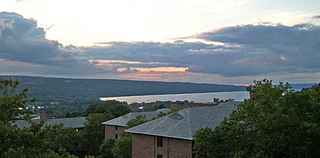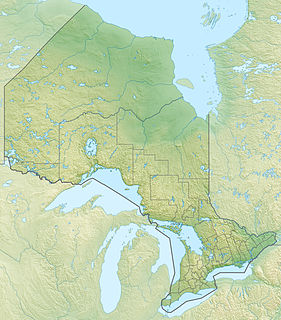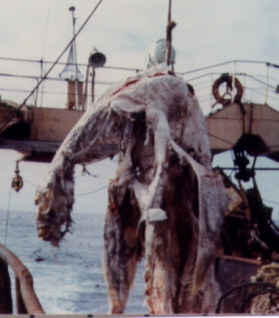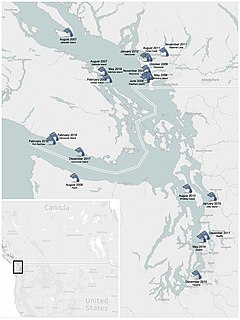Related Research Articles

Cayuga Lake is the longest of central New York's glacial Finger Lakes, and is the second largest in surface area and second largest in volume. It is just under 39 miles (63 km) long. Its average width is 1.7 miles (2.8 km), and it is 3.5 mi wide (5.6 km) at its widest point, near Aurora. It is approximately 435 ft deep (133 m) at its deepest point, and has over 95 miles (153 km) of shoreline.

The Loch Ness Monster, or Nessie, is a creature in Scottish folklore that is said to inhabit Loch Ness in the Scottish Highlands. It is often described as large, long-necked, and with one or more humps protruding from the water. Popular interest and belief in the creature has varied since it was brought to worldwide attention in 1933. Evidence of its existence is anecdotal, with a number of disputed photographs and sonar readings.

Sea monsters are beings from folklore believed to dwell in the sea and often imagined to be of immense size. Marine monsters can take many forms, including sea dragons, sea serpents, or tentacled beasts. They can be slimy and scaly and are often pictured threatening ships or spouting jets of water. The definition of a "monster" is subjective; further, some sea monsters may have been based on scientifically accepted creatures, such as whales and types of giant and colossal squid.
Cadborosaurus, nicknamed Caddy named by journalist Archie Wills, is a sea serpent in the folklore of regions of the Pacific Coast of North America. Its name is derived from Cadboro Bay in Greater Victoria, British Columbia, and the Greek root word "saurus" meaning lizard or reptile.

A lake monster is a lake-dwelling entity in folklore. The most famous example is the Loch Ness Monster. Depictions of lake monsters are often similar to those of sea monsters.
Lake Tianchi Monster is the name given to what is said to be a lake monster that lives in Heaven Lake located in the peak of Baekdu Mountain within the Baekdudaegan and Changbai mountain ranges encompassing Jilin Province of China and Ryanggang Province of North Korea. According to Beijing Youth Daily, an estimated 20 monsters were reported, however "scientists are skeptical that any large creature would be able to survive in the lake given its recent history of volcanic activity", and skeptics say "it's all in the imagination, or just a floating volcanic rock".

In Canadian folklore, the Ogopogo is a lake monster said to inhabit Okanagan Lake in British Columbia, Canada. Some scholars have charted the entity's development from First Nations folklore and widespread water monster folklore motifs. The Ogopogo now plays a role in the commercial symbolism and media representation of the region.

Trunko is the nickname for a large unidentified lump of flesh or a decomposed sea creature, a so-called "globster", reportedly sighted in Margate, South Africa on 25 October 1924. The initial source for Trunko was an article entitled "Fish Like A Polar Bear" published on the 27 December 1924, edition of London's Daily Mail. The animal was reportedly first seen off the coast battling two killer whales, which fought the unusual creature for three hours. It used its tail to attack the whales and reportedly lifted itself out of the water by about 20 feet (6 m). One of the witnesses, South African farmer Hugh Ballance, described the animal as looking like a "giant polar bear" due to what was thought to be dense-white fur.

The Fawn River is a river in the north of the Unorganized Part of Kenora District in Northwestern Ontario, Canada. It is in the Hudson Bay drainage basin and is a right tributary of the Severn River.

A globster or blob is an unidentified organic mass that washes up on the shoreline of an ocean or other body of water. A globster is distinguished from a normal beached carcass by being hard to identify, at least by initial untrained observers, and by creating controversy as to its identity.

The Zuiyo-maru carcass was a corpse, most likely a basking shark, caught by the Japanese fishing trawler Zuiyō Maru (瑞洋丸) off the coast of New Zealand in 1977. The carcass's peculiar appearance led to speculation that it might be the remains of a sea serpent or prehistoric plesiosaur.
In Canadian folklore, the Manipogo is a lake monster said to live in Lake Manitoba, Manitoba, Canada. The creature was dubbed Manipogo in 1960, the name echoing British Columbia's Ogopogo. There is also a Lake Winnipegosis monster called Winnepogo, thought possibly to be the same creature since the lakes are connected. It is the namesake of the Manipogo Provincial Park.

Nahuelito is a cryptid lake monster purported to live in Nahuel Huapi Lake, Patagonia, Argentina. Like Nessie, the Loch Ness Monster, the Argentine creature is named after the lake it supposedly resides in and has been described as a giant serpent or a huge hump, as well as a plesiosaur. Nahuelito has been allegedly shown through photos showing a hump, or a serpentine body.

Kitchenuhmaykoosib Inninuwug, also known as Big Trout Lake First Nation or KI for short, is an Oji-Cree First Nation reserve in Northwestern Ontario and is a part of Treaty 9. The community is about 580 km (360 mi) north of Thunder Bay, Ontario.

Trout Lake is a lake in municipalities of East Ferris and North Bay, Nipissing District in Northeastern Ontario, Canada, approximately 6 kilometres (4 mi) east of the much larger Lake Nipissing. Trout Lake is the source of the Mattawa River and a significant body of water on a well-known historic North American voyageur (fur-trading) route. It is about 11 kilometres (7 mi) long and 4 kilometres (2 mi) wide and exits eastward into the Mattawa River, which flows via the Ottawa River to the St. Lawrence River. Some of the most difficult portages are found on this part of the voyageur route between Trout Lake and the end of the Mattawa River, e.g., Portage de Mauvaise Musique, located at the Talon Chute.

Since August 20, 2007, at least 20 detached human feet have been found on the coasts of the Salish Sea in British Columbia, Canada, and Washington, US. The first discovery, on August 20, 2007, was on Jedediah Island in British Columbia. Feet have been discovered on the coasts of islands in British Columbia, and in the US cities of Tacoma and Seattle.

The "Montauk Monster" was an animal carcass that washed ashore on a beach near the business district of Montauk, New York, in July 2008. The identity of the creature and the veracity of stories surrounding it have been the subject of controversy and speculation.

Cameron Lake is a lake in central Vancouver Island located 15 km east of Port Alberni, on the north side of Highway 4. It has an area of 477 hectares and an elevation of 184 metres above sea level. The lake is between Mount Arrowsmith to the south and Mount Wesley to the north. The lake was named by Captain Richards in 1860 for David Cameron, the first Chief Justice of Vancouver Island.

The "Panama Creature" refers to a carcass photographed near the town of Cerro Azul, Panama, in September 2009. After the animal was discovered and reputedly killed by a group of teenagers, photographs of the corpse were given to Telemetro, a Panamanian television station. The story and pictures circulated, and comparisons to the Montauk Monster were made. There was speculation about the identity of the creature, with suggestions including a hairless sloth, an alien species and a creature new to science. A biopsy performed by the National Environmental Authority of Panama on the remains a few days after the creature's discovery concluded that the corpse was in fact that of a male brown-throated sloth. The odd appearance had been caused by underwater decomposition, which had resulted in hair loss. Once identified, the corpse was buried.

The Mugwump is a lake monster which has been alleged to live in Lake Timiskaming, on the border of the Canadian provinces of Ontario and Quebec.
References
- ↑ Mahoney, Jill (May 21, 2010). "Big Trout Lake 'monster' sparks Internet debate". The Globe and Mail.
- ↑ News Staff, CTV.ca. "Mystery surrounds creature found in Ont. creek". CTV News . Bell Media. Retrieved 22 December 2019.
- ↑ Potkins, Meghan (May 21, 2010). "Update: Northern Ontario mystery creature likely a decomposing mink, says professor". National Post . Retrieved 22 December 2019.